Being a ‘TV Typewriter’ and all, it goes without saying that the keyboard is a rather important component of the thing. No matter how well you design the electronics, they’re useless unless you have a physical means to input data. And new keyboards in 1973 were expensive. Unless, of course, you read Radio Electronics for tips on how to get around that problem.
Not that the TVT required an actual keyboard. In the September 1973 Radio Electronics article, Don Lancaster suggested ‘six switches and a pushbutton’ would suffice. Entering letters was a matter of setting the switches and pressing the button. Don claimed with practice decent speed could be achieved, although I think he must have been a pianist to make that arrangement work with any proficiency. Another option was the ‘low cost keyboard’ project offered in the February 1973 issue of RE. Part of Don’s ingenuity was finding extremely affordable ways of doing things; his handmade key switches were crude but brilliant, although you still needed to secure keycaps from somewhere. RE suggested ‘two shot’ moulded plastic keytops made by a company called Mechanical Enterprises of Arlington, Virginia. I have no idea if they still exist. The keytops themselves look pretty close to those found on IBM Selectric typewriters, except for extra functions printed over the letters. You also needed to build your own ASCII encoder which would convert the signals generated into letters and numbers that would appear on your screen.
My first order of business in choosing to model Don’s prototype was to find out what kind of keyboard he used. To refresh, here’s what the prototype keyboard looks like:

When I asked him about it, his response was that the keyboard was an ‘IBM EBCDIC’ surplus unit. They had taken apart dozens of them and reconfigured into just over 40 complete units that were then offered to TVT builders. I tried to google search using what he had given me but came up short; EBCDIC, which stands for Extended Binary Coded Decimal Interchange Code, like ASCII, was an encoding standard used my several keyboard manufacturers, not a specific model. I asked in forums, on mailing lists. Some claimed familiarity, but could only suggest they were ‘key to tape’ units. One day I got an old school computer hobbyist who remembered something about the TVT prototype using surplus Mohawk ‘key to tape’ keyboards. Again I went to Captain Google, and again he came up short. All I had were photos of the prototype.
I realized I needed a Plan B, because finding anything involving key to tape or punch cards from 1973 today might prove to be impossible. I thought perhaps I could recreate the keytops on the prototype by finding parts that were close and fashioning something that resembled them. The underlying switches wouldn’t matter; they wouldn’t be seen. Since the keytops looked kind of like teletype keys, I did some ebaying around for ‘teletype keys’, and one day came up lucky. A vendor had 62 ‘Repeat’ replacement keys for military teletypes. Apart from every one having ‘REPT’ stamped on it, they looked pretty close to what Don’s prototype had. I figured making them look like the prototype would just be a matter of painting them. So I ordered all of them. Here’s what they looked like:
If you look at the photo of the actual TVT prototype keyboard again, you’ll see these cylinders are set in the lower right corner of black square surrounds that are there to hide the switches underneath. I assumed (incorrectly) that cylindrical keys slid down through the surrounds when pressed. Thanks to my years of model railroading, I had learned how to cast plastic parts using two part resin. I reasoned I could approximate the dimensions of these surrounds, create a mockup of one in styrene, and then make a mould of it and cast it. Then I could adapt the ‘low cost keyboard’ project from the earlier RE article to it, creating a working keyboard that at least had the same exterior look.
I had that all settled up and began making plans, but then one day I had a stroke of luck and ebay coughed up just what I needed. While searching for ‘Mohawk keyboard’, sure enough, one came up. It looked just like this:

After close inspection it became very clear this keyboard was what Don had used! The placement and design of the keys were correct, the only difference being colour. Woohoo! This was it: an original Mohawk Data Sciences (MDS) key to tape system keyboard.
My understanding is that key-to-tape was a system that avoided the need to punch data into paper cards. MDS apparently did very well for a time, up until about the late 1970s. I don’t know for sure what happened to them but I imagined it was the same fate as many other proprietary computer brands as the world slowly converged into widely held standards. Many old hands refer to them as ‘IBM Mohawk’, but I see nothing to indicate IBM’s involvement anywhere at the time these key to tape systems were being produced. Perhaps someone can clarify.
My elation at finally locating it was was stopped cold by the asking price, though: a cool $600. I asked around on forums for opinions; even though the price was extremely steep, I reckoned the odds of coming across another unit like this any time soon were slim to none. I was assured that these keyboards were nothing special — just salvage from old Mohawk key to tape units that had once been plentiful. Most said they wouldn’t offer more than $50. I asked the seller if they’d consider offers. They declined, but eventually relisted for $100. I opted to sit out, hoping it would go unsold and be marked down again, but it sold for just over $100. I felt a little bummed — I knew these keyboards didn’t come up every day, and since the sellers themselves didn’t know what they were, searching them out on ebay would require hours of looking up every keyboard in the Vintage Computing section. Who knows when I might see one again? But then a year later, I did! The asking price this time was $100 and I went for it. Here it is:
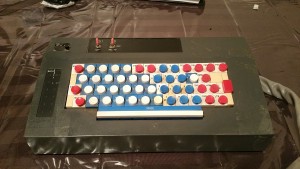
Interestingly, it’s not exactly the same as the first one I encountered. There are fewer switches up top, and the keys are coloured differently. I’m guessing Mohawk customized these things depending on client and application. Perhaps someone could shed some light on that. The keyboard itself isn’t all that big, maybe about 18 inches wide, but man is it heavy. You know those ‘steelie’ IBM clicky keyboards? They have nothing on this beast. Here’s a few shots around it:
Way cool. There are five screws to remove to get into it, and upon removing the case we are presented with the innards:
The keys themselves sit a good few inches up from the base. Compared to modern keyboards, the space inside is cavernous.
I was surprised to find a speaker in there. I’m assuming that was there to alert to errors and so on. The wire bundle looks pretty intimidating given how many there are. Keeping all that straight looks to be a challenge. In terms of operation, I was expecting a much more mechanical, clunky feel to them as several forum folks had said these key to tape units were a nightmare to type on (I actually found pressing the keys to be relatively smooth, although a bit awkward with the small size and wide spacing). The switches themselves I *think* are faily simple contact switches — two wires each, press it down and the circuit is connected. I’m hoping Don chose these for relative simplicity. I was also wrong about how they operate — when you press on the cylinders, the entire thing, surround included, moves down. The switch mechanism itself below the keytops seem massive for what they are.
You can see in this side profile view the solid blocks installed as spacers. On my keyboard there is a single rectangular ‘LF’ key on the right side. This key does not exist on the first ebay keyboard I came across; rather it is blocked off.
According to Don, he cherry picked blue, red and black keytops from various keyboards for colour, and reassembled them to get the patterns seen in the prototype. Based on what we can see here, it looks like before or after changing/painting keycaps, he removed some keys on the right side and blocked them in, dropped the whole keyboard into his TVT prototype case, and then to center it and hide the metal framing he used to mount it, added a vertical column of blocks on the left side, making it one column wider than it was originally. Neat! I don’t have enough ‘blocks’ to fill in the keys I will have to remove, but those should be easy enough to cast in resin and paint.
To be honest, I’m almost a little hesitant to take this apart. The forum gurus say these units aren’t rare or collectible, but I’ve never seen one myself before and they can’t be that numerous after 40+ years. It’s just a neat thing to look at and appreciate how much keyboards generally have evolved over the years. The thought of painting over the original decaling is perhaps just a bit bothersome to me. I’m sure I’ll get over it, but for now, until we get to the actual construction phase, I’ll enjoy it as is.
Next up, the ICs.
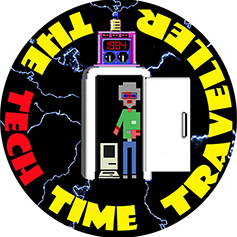
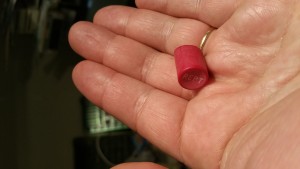
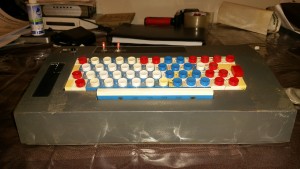
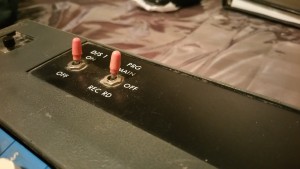
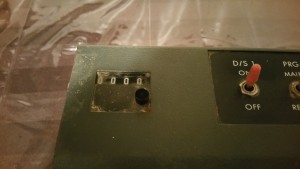
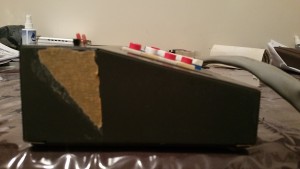
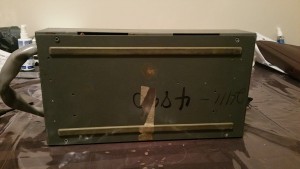
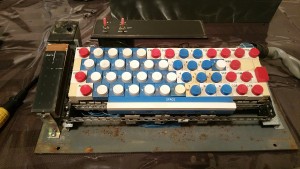
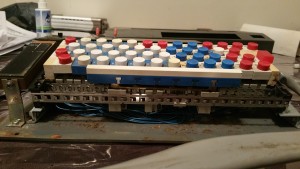
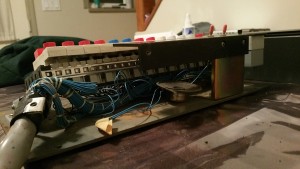
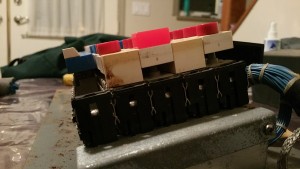
Sorry about that, it seems I’m the one that snagged it first (it’s taken me a while to post pictures of it though).
https://www.flickr.com/photos/triplehaata/albums/72157647400411814
http://deskthority.net/photos-f62/mohawk-data-sciences-keyboard-t12471.html
Thanks for confirming that it’s indeed a MDS keyboard. My first searches didn’t really show much.
As for rarity, I’ve only ever seen two of these pop up on ebay (and I’ve been doing this for years).
The switches are made by Honeywell, Micro Switch division (date codes are on the sides). They’re magnetic reed switches (you’ll be able to faintly hear the reeds slapping together when you press a key).
Mine seems to be from around 1966 (with a replacement switch from 1970). I’d recommend against taking the switch apart (safe to take out of the brackets though) because the plastic is pretty brittle. Had one break on me while taking pictures and had to superglue the top back on…